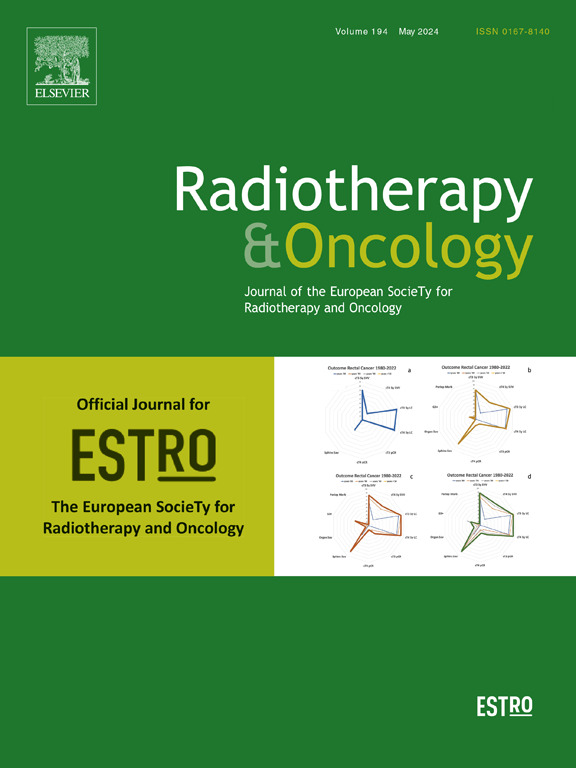Development of learning-based predictive models for radiation-induced atrial fibrillation in non-small cell lung cancer patients by integrating patient-specific clinical, dosimetry, and diagnostic information
IF 4.9
1区 医学
Q1 ONCOLOGY
引用次数: 0
Abstract
Background and purpose
Radiotherapy (RT) in non-small cell lung cancer (NSCLC) can induce cardiac adverse events, including atrial fibrillation (AF), despite advanced RT. This study integrates patient-specific information to develop learning-based models to predict the incidence of AF following NSCLC chemoradiotherapy (CRT) and evaluates these models using institutional and external datasets.
Materials and methods
Institutional and external patient cohorts consisted of 321 and 187 NSCLC datasets who received definitive CRT, including 17 and 6 AF incidences, respectively. The network input had 159 features with clinical, dosimetry, and diagnostic. The class imbalance was mitigated by synthetic minority oversampling technique. To handle various types of input features, machine learning-based model adopted an intervention technique that chose one feature with the largest weight at each dosimetry sub-group in feature selection process, while deep learning-based model employed a hybrid architecture assigning different types of networks to corresponding input paths. Performance was assessed by area under the curve (AUC). The key features were investigated for the machine and deep learning-based models.
Results
The hybrid deep learning model outperformed the machine learning-based algorithm in internal validation (AUC: 0.817 vs. 0.801) and produced more consistent performance in external validation (AUC: 0.806 vs. 0.776). Importantly, maximum dose to heart and sinoatrial node (SAN) were found to be the key features for both learning-based models in external and internal validations.
Conclusions
The learning-based predictive models showed consistent prediction performance across internal and external cohorts, identifying maximum heart and SAN dose as key features for the incidence of AF.
通过整合特定患者的临床、剂量测定和诊断信息,开发基于学习的非小细胞肺癌患者辐射诱发心房颤动预测模型。
背景和目的:非小细胞肺癌(NSCLC)放疗(RT)可诱发心脏不良事件,包括心房颤动(AF),尽管是晚期RT。本研究整合了患者特异性信息,开发了基于学习的模型来预测NSCLC化学放疗(CRT)后房颤的发生率,并利用机构和外部数据集对这些模型进行了评估:机构和外部患者队列分别由 321 个和 187 个接受明确 CRT 的 NSCLC 数据集组成,其中分别包括 17 例和 6 例房颤。网络输入有 159 个临床、剂量测定和诊断特征。通过合成少数超采样技术缓解了类不平衡问题。为了处理各种类型的输入特征,基于机器学习的模型采用了干预技术,在特征选择过程中,每个剂量测定子群选择一个权重最大的特征,而基于深度学习的模型则采用了混合架构,将不同类型的网络分配到相应的输入路径。性能通过曲线下面积(AUC)进行评估。对机器模型和基于深度学习的模型的关键特征进行了研究:混合深度学习模型在内部验证(AUC:0.817 对 0.801)中的表现优于基于机器学习的算法,在外部验证(AUC:0.806 对 0.776)中的表现更加一致。重要的是,在外部和内部验证中发现,心脏最大剂量和中房结点(SAN)是两种基于学习的模型的关键特征:基于学习的预测模型在内部和外部队列中显示出一致的预测性能,确定心脏和 SAN 的最大剂量是房颤发生率的关键特征。
本文章由计算机程序翻译,如有差异,请以英文原文为准。
求助全文
约1分钟内获得全文
求助全文
来源期刊

Radiotherapy and Oncology
医学-核医学
CiteScore
10.30
自引率
10.50%
发文量
2445
审稿时长
45 days
期刊介绍:
Radiotherapy and Oncology publishes papers describing original research as well as review articles. It covers areas of interest relating to radiation oncology. This includes: clinical radiotherapy, combined modality treatment, translational studies, epidemiological outcomes, imaging, dosimetry, and radiation therapy planning, experimental work in radiobiology, chemobiology, hyperthermia and tumour biology, as well as data science in radiation oncology and physics aspects relevant to oncology.Papers on more general aspects of interest to the radiation oncologist including chemotherapy, surgery and immunology are also published.
 求助内容:
求助内容: 应助结果提醒方式:
应助结果提醒方式:


